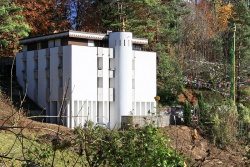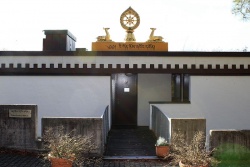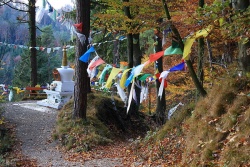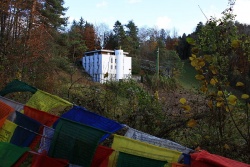Tibet Institute Rikon
The Tibet Institute Rikon is a Tibetan Monastery located in Zell-Rikon im Tösstal in the Töss Valley in Switzerland. It is an established as a non-profit foundation because Swiss laws resulting from the 19th century secularization movement do not allow for the establishment of new Monasteries.
History
In 1961, Switzerland was one of the first countries in the Western hemisphere that allowed Tibetan refugees to settle in large numbers. Henri and Jacques Kuhn (owner of Metallwarenfabrik AG Heinrich Kuhn, now Kuhn Rikon AG) offered work and accommodations to a group of refugees. They helped found a monastic Tibet Institute for Spiritual and cultural care of Tibetan people in Switzerland, which would also preserve and maintain the Tibetan culture for future generations. The monastic Tibet Institute in Rikon was established according to the advice and under the patronage of His Holiness the 14th Dalai Lama, who emphasized the importance of Monasteries for Tibetan people in exile. H.H. the Dalai Lama sent an abbot and four Monks to Rikon from India. The Institute's buildings were designed by architect Ueli Flück (Baden AG), and the foundation stone was laid on July 29, 1967. On November 9, 1968, the monastic Tibet Institute was consecrated by H.H. the Dalai Lama's two principal teachers, Trijang Rinpoche and Ling Rinpoche. On April 8, 2010, His Holiness the 14th Dalai Lama visited the Monastery community in Rikon for the 14th Time, and was warmly received by Tibetan people, on the occasion of the 50th anniversary of the establishment of Tibetan refugees in Switzerland.
Institute's building
The Institute building was designed in a functional western style which incorporates traditional Tibetan elements. The overall design was not based on traditional Tibetan sacred architecture, because this would have reflected the altered role of a Tibetan Monastery in the West in a misleading manner.
Cultural and religious Life
Today the Buddhist Monastery and its monastic community is a vital part of the cultural and religious Life of Tibetan people in Switzerland. The large variety of cultural Activities of the Tibet Institute also provide an important forum for the constantly growing number of Western people Interested in Buddhism and Tibet. The institute promotes the understanding of Tibetan culture for both the general public and for specialists. It organizes public events, maintains its own library, issues its own publications, provides support to students and researchers, engages in public relations and outreach, and maintains contacts with related institutions. Its project «Science meets Dharma» provides Tibetan Monks and Nuns access to western scientific culture.
The Tibet Institute Rikon provides for the Spiritual and cultural needs of Tibetans in Switzerland, striving to preserve Tibetan culture and Religion for the benefit of future generations of Tibetans. It makes Tibetan culture accessible to Interested western and other non-Tibetan people. The monastic community supports scientific research in the field of Tibetology and is promoting dialogue between Buddhist Philosophy and western science.
Monastic community
In 2009, the monastic community comprised 9 Tibetan Monks. Ven. Geshe Phuntsok Tashi, the fourth abbot, was appointed by H.H. the 14th Dalai Lama in 1996. Since 2007, the Monastery has had representatives of all four great traditions of Tibetan Buddhism: Nyingma, Kagyu, Sakya and Gelug.
- Ven. Geshe Ugyen Tseten (1st abbot, 1967–1974)
- Ven. Geshe Tamdin Rabten (2nd abbot, 1975–1979)
- Ven. Geshe Gedün Sangpo (3rd abbot, 1979–1995)
- Ven. Geshe Phuntsok Tashi (4th abbot, since 1996)



